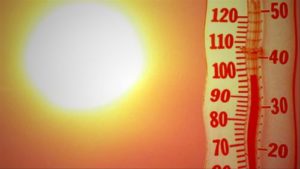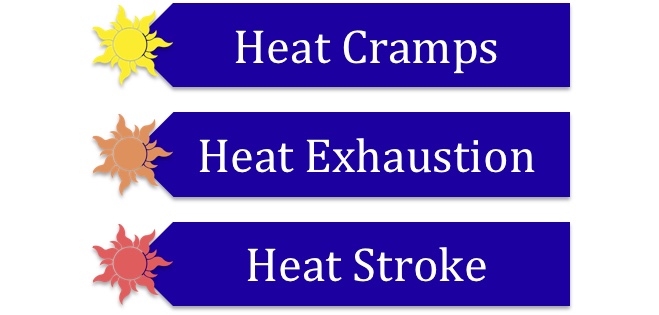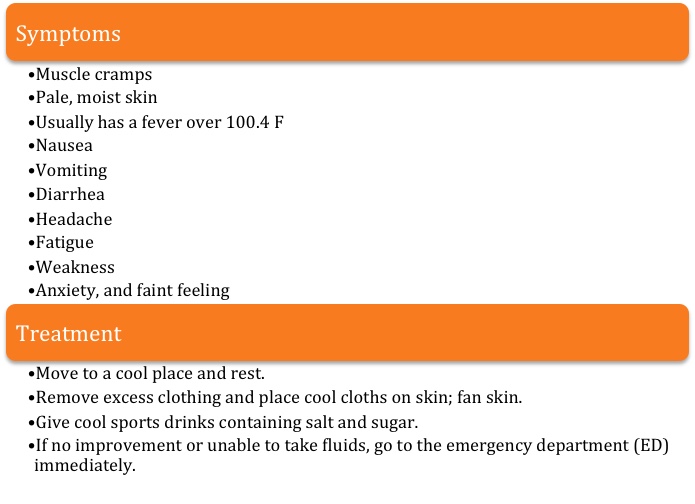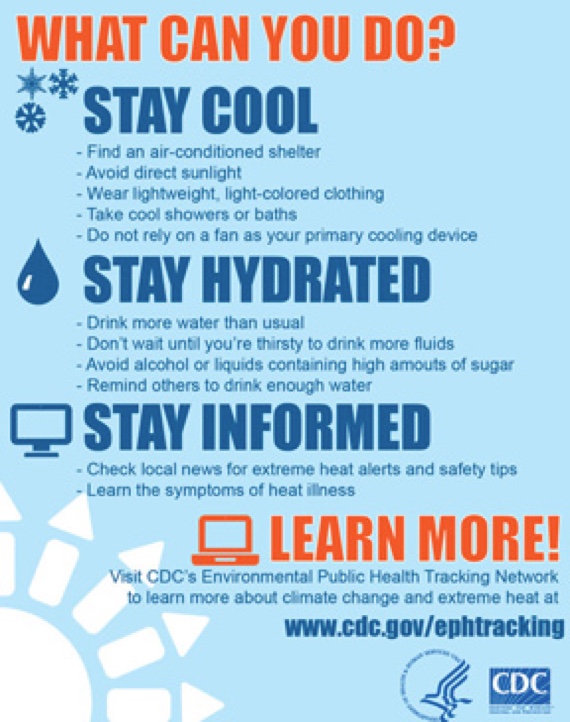Posts Tagged ‘Heat Exhaustion’
Heatstroke, Heat Exhaustion, and Dehydration. By Our Student Pharmacist, Steve McVey.
The arrival of summer brings us sunny weather and many opportunities for outdoor activities. With the good weather, it is important to be mindful of spending excessive amounts of time in the heat. The Centers for Disease Control (CDC) reports that heat-related illnesses, including dehydration, heat exhaustion, and heatstroke, cause approximately 600 deaths per year and all pose serious risks. However heat-related illnesses are preventable if you take the right precautions and watch for danger signs.
Higher temperatures, muggy or humid weather, and sun exposure can all increase the risk of heat-related illness. Under any of these conditions, the body may overheat and not be able to cool down properly. We normally sweat to help our bodies cool down, but dehydration, dry skin, or sunburn can stop the skin from sweating or releasing heat properly. However, in some circumstances, even proper sweating may not be enough to cool down our body temperature.
Some special populations including older adults, young children, people with other health conditions, and athletes are all at an increased risk from prolonged heat exposure.
Visit this CDC link to find more information about protecting at risk populations.
Heatstroke may be caused by either strenuous activity or simply being in a hot environment for an extended period of time. Other factors like wearing too much clothing, drinking alcohol, or dehydration can lead to heatstroke. Heat exhaustion is often caused by the same conditions and circumstances and can lead to heatstroke.
Hallmark signs of heatstroke and heat exhaustion include increased body temperature, with heatstroke being above 103℉ and heat exhaustion being above the normal 98.6℉. A person with heatstroke may have hot, red, dry, or damp skin and may have a throbbing headache. Those with heat exhaustion usually sweat excessively and their skin may be cool or damp. Heat cramps are often the first sign of heat exhaustion.
You can click here for a chart with more information about signs and symptoms
It is important to stay hydrated and limit exposure to heat and sunlight. Everyone should increase their water intake during summer months regardless of how much exercise or activity you are getting. Do not wait until you are thirsty to drink. If you are fluid restricted, ask your doctor about how much you should drink.
You can also help prevent heat-related illness by dressing in lightweight, light colored, and loose fitting clothing. Plan outdoor activities in the morning and evenings to avoid the hottest times of the day. Apply sunscreen, at least SPF 15 or higher, 30 minutes before sun exposure and reapply according to package instructions. Stay indoors when possible in a cool, air conditioned room. Fans may help with comfort, but air conditioning is needed in extreme heat to help lower body temperature. Never leave anyone, child or adult or pet, in a car in hot weather. Temperatures may reach upwards of 110℉ in as little as 20 minutes.
If you suspect someone is suffering from heatstroke, call 911 immediately, move them to a shady area, and cool their body temperature rapidly with cool baths/water. Do not give them anything to drink. If someone is experiencing heat exhaustion, use similar methods to cool them down, and give them cool water to sip. Heat cramps may be treated with rest and cool sports drinks or juice.
You can find more information about how to treat heat-related illnesses here.
Remember to stay hydrated, stay informed, and stay safe while enjoying the summer weather.
References:
- About Extreme Heat. Centers for Disease Control and Prevention. https://www.cdc.gov/disasters/extremeheat/heat_guide.html. Updated June 19, 2017. Accessed June 6, 2019.
- Frequently Asked Questions (FAQ) About Extreme Heat. Centers for Disease Control and Prevention. https://www.cdc.gov/disasters/extremeheat/faq.html. Reviewed June 1, 2012. Accessed June 6, 2019.
- Protecting Vulnerable Groups From Extreme Heat. Centers for Disease Control and Prevention. https://www.cdc.gov/disasters/extremeheat/specificgroups.html. Reviewed June 19, 2017. Accessed June 6, 2019.
- Tips for Preventing Heat-Related Illness. Centers for Disease Control and Prevention. https://www.cdc.gov/disasters/extremeheat/heattips.html. Reviewed June 19, 2017. Accessed June 6, 2019.
- Mayo Clinic Staff. Heatstroke. Mayo Clinic. https://www.mayoclinic.org/diseases-conditions/heat-stroke/symptoms-causes/syc-20353581. Reviewed August 15, 2017. Accessed June 6, 2019.
- Mayo Clinic Staff. Heat Exhaustion. Mayo Clinic. https://www.mayoclinic.org/diseases-conditions/heat-exhaustion/symptoms-causes/syc-20373250. Reviewed December 14, 2017. Accessed June 6, 2019.
- Warning Signs and Symptoms of Heat-Related Illness. Centers for Disease Control and Prevention. https://www.cdc.gov/disasters/extremeheat/warning.html. Reviewed September 1, 2017. Accessed June 6, 2019.
Dehydration pic link https://www.accesssportsmed.com/news/how-to-tell-youre-dehydrated/
Heat pic link https://northendwaterfront.com/2018/07/tips-for-beating-the-summer-heat/
Drinking water link https://centralflawatertreatment.com/clean-and-healthy-drinking-water
Stay Cool and Stay Hydrated. By Our July Student Pharmacist, Kevin Wenceslao.
As longtime Columbus meteorologist Marshall McPeek would say, this summer has been “hazy, hot, and humid.”
This past week alone, the average temperature was 84℉ with the humidity around 97%. Not only does the high temperature and humidity lower the air quality, these factors also put many people at risk for dehydration and heat-related illness.
According to the Centers for Disease Control and Prevention (CDC), around 618 people in the U.S. are killed by extreme heat each year despite the fact that heat-related illnesses and deaths are preventable.
By understanding the warning signs of dehydration and learning how to treat and prevent those symptoms, we can help reduce the number of heat-related incidents.
To start off, dehydration is defined by excess loss of water from the body. Water is required by the body to function normally. Typically, there should be a balance between water intake and output, but that can be disrupted by various factors:
- Excessive heat
- Physical activity
- Vomiting
- Diarrhea
- Sickness/High Fever
- Medications, like diuretics (cause urination) or laxatives (cause watery bowel movements)
- Barriers to fluid intake (sore throat or upset stomach)
In order to recognize if someone is dehydrated, there are symptoms that you can watch out for.
Mild symptoms include:
- Feeling thirsty
- Urinating less often
- Having dark urine
- Having a dry mouth.
As dehydration becomes more severe, other symptoms may develop such as:
- Fatigue
- Confusion
- Feeling light-headed.
The best way to treat dehydration is with fluids. Mild dehydration can often be self-treated by drinking water, sports drinks, or rehydration liquids such as Pedialyte, which all can be found here at Plain City Druggist. If symptoms continue or worsen over a few days, it is important to call your doctor to get help. In cases of severe dehydration, people are given intravenous fluids through an IV at the hospital.
In summers like these, the extreme heat makes us more prone to dehydration. Not only does the hot weather directly increase our body temperatures, but it also causes us to sweat profusely and lose water more quickly.
Sweating is an important cooling mechanism for the body. As the water droplets evaporate from our skin, they also take away heat. When we are dehydrated, we lose that ability to produce sweat and cool ourselves down. If the body’s core temperature is too high, the vital organs and brain can be damaged, which leads to heat exhaustion, and, in extreme cases, heat stroke. In these severe cases, it is important to cool the affected person down and get the appropriate emergency help.
Fortunately, dehydration is a preventable condition. Proper hydration is key, and it is important to drink throughout the day even if you’re not feeling thirsty. In hot weather or during times of physical activity, you should also drink more than you think is actually necessary.
Staying cool is also a great way to avoid dehydration. Stay indoors and avoid doing outdoor work during the hottest parts of the day from noon to 3 PM.
If being outside is unavoidable, make sure to wear a hat and loose-fitting clothing, apply sunscreen, and plan frequent breaks to drink water and cool down.
More importantly, certain people are also at greater risk of dehydration and of developing heat related illness. These include older adults over the age of 65, people with chronic medical conditions, children, and infants. Keep a close eye on friends and family during these hot and humid days, and encourage each other to stay cool and stay hydrated. If you have more questions, the CDC website is a great place to visit for tips or pop into our air-conditioned pharmacy to talk to your local pharmacist!
References:
Natural Disasters and Severe Weather. Centers for Disease Control and Prevention. (2017, June 19). Retrieved July 21, 2017, from https://www.cdc.gov/disasters/extremeheat/index.html
Patient Education: Dehydration (The Basics). UpToDate. Retrieved July 21, 2017, from https://www-uptodate-com.proxy.lib.ohio-state.edu/contents/dehydration-the-basics?source=see_link
Image Sources:
https://vignette2.wikia.nocookie.net/phobia/images/6/69/Hot_Weather.jpg/revision/latest/scale-to-width-down/1000?cb=20161109044912
https://www.fix.com/assets/content/19035/signs-of-dehydration-001.png
http://www.nws.noaa.gov/om/heat/heat-illness.shtml
Heat Related Illnesses. By Our August Student Pharmacist, Ben Coles.
With the summer swelter still in full swing, it might continue to be difficult getting and staying cool. But what happens when our bodies lose the fight to cool down and get too hot? While our bodies naturally tell us to rest and increase sweat production and secretion when the temperature gets too high, sometimes we may succumb to a heat-related illness.
There are three different heat-related illnesses of different degrees of severity:
Heat cramps are the mildest form of heat-related illness and thus have the mildest symptoms.
The symptoms, as well as treatments, of heat cramps are explained below:
Heat exhaustion is more severe and is caused by the loss of water without fluid replacement. If not treated, heat exhaustion can progress to heat stroke.
The symptoms and treatments of heat exhaustion are explained below:
Heat stroke is the most severe form of heat-related illness and is a medical emergency that needs treated immediately.
The symptoms and treatments for heat stroke are listed below:
Although heat-related illnesses can become very serious, the primary goal is to prevent anyone from progressing to one of these states. There are plenty of habits we can employ to stay hydrated and cool.
Let’s do all we can to enjoy the rest of our summer while staying hydrated and cool. For more information, visit: CDC.gov/extremeheat.
Heat Safety. By Our “Special K” Pharmacy Student, Kelly Banker.
Hello everyone, this is Kelly Banker blogging to you for Plain City Druggist. I am a pharmacy student doing an internship at PCD for the month of July. With the recent high July temperatures in the area, I wanted to take some time to remind readers of important heat safety tips.
Never, ever leave children or pets in your car. Also be sure to keep cars locked when not in use so that children can’t play in the car and become locked inside. Since 1998, there have been almost 500 heat related deaths of infants and children due to being left in a closed vehicle. As this simulation shows, a closed car on a 90° day can quickly increase to deadly temperatures: up to 109° within 10 minutes and up to 133° within an hour.
Car interior becomes an oven simulation: http://www.weather.com/newscenter/specialtopics/slideshows/hotcar061909.html?page=1&scheme=image-horiz-plain.css
Additionally, the National Highway Traffic Safety Administration is urging parents and other caregivers to think, “Where’s baby? Look before you lock.” Unfortunately, many infants and small children die each year in hot cars, because they have fallen asleep in their car seats and are then forgotten in cars by busy adults.
Use the buddy system. It is estimated that during the Chicago heat wave of 1995, over 700 people died of heat related illnesses. Many of these deaths were elderly people who had no air conditioning and no one to check up on them. If you have a job working outside in the heat or live by yourself, ask someone to call and check on you at least daily. If you know anyone over the age of 65 or have elderly neighbors, be sure to check up on them during this hot weather.
Stay hydrated. If you spend any time outside in hot weather, you should increase your fluid intake. Water, sports drinks, and foods high in water content like fruits and vegetables (think watermelon!) are all good ways to stay hydrated. Avoid beverages containing alcohol or caffeine which will worsen dehydration. If you are taking your pets with you somewhere, remember to bring them plenty of water, too. Symptoms of dehydration include dark colored urine, weakness, dry mouth, headache, dizziness, decreased tears and sweating and tiredness. Young children, the elderly, people with chronic disease and people taking certain medications are at increased risk. More information on dehydration can be found here: http://www.mayoclinic.com/health/dehydration/DS00561
Known the signs and symptoms of heat exhaustion and heat stroke. A person with heat exhaustion may have symptoms similar to but more severe than dehydration as well as muscle and abdomen cramps, nausea, vomiting, increased pulse rate, and low blood pressure. Their body temperature is usually near normal and they can be treated by drinking fluids, moving out of the heat and attempting to cool off using a cool shower. Heat stroke is a more serious condition in which the body becomes unable to control its temperature. People with heat stroke usually have highly increased body temperatures, often over 103° F, with associated neurologic symptoms such as bizarre behaviors, psychosis, seizures, tremor, and confusion. They may also have red, hot skin, and an absence of sweating. Classic heat stroke develops slowly over several days. If you or someone you know has symptoms of heat stroke, call for medical assistance immediately and begin trying to cool them. For more information about staying safe in the heat or symptoms of heat stroke, click on the links below:
http://www.mayoclinic.com/health/exercise/HQ00316
http://www.mayoclinic.com/health/heat-stroke/DS01025
If you have any questions, feel free to call us here at Plain City Druggist. Enjoy your summer and stay cool!













